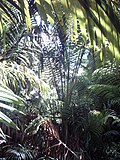Metroxylon





Metroxylon is a genus of palm trees, belonging to the family Arecaceae. This genus is notable for its economic importance in tropical regions, particularly for the species Metroxylon sagu, which is the primary source of sago, a starch extracted from the pith of these trees. Sago is a staple food in parts of Melanesia, Micronesia, and Indonesia, serving as a major carbohydrate source in these regions.
Description[edit]
Metroxylon palms are characterized by their large, robust size and the ability to form clusters of stems from basal offshoots. These palms can reach heights of up to 30 meters. The leaves are large, pinnate, and can span several meters in length. The flowers are small, with both male and female flowers typically found on the same inflorescence, making the plant monoecious. After flowering, the plant often dies, following a monocarpic pattern of growth where it flowers once then dies.
Distribution and Habitat[edit]
The Metroxylon genus is native to tropical Asia and the western Pacific islands. These palms thrive in wet, swampy environments, often found in lowland rainforests and freshwater swamps. The distribution of Metroxylon palms is closely tied to regions where sago is a dietary staple, reflecting the plant's importance in local agriculture and economies.
Economic Importance[edit]
The most economically significant species within this genus is Metroxylon sagu, widely cultivated for its starch-rich pith. Sago from this palm serves as a primary food source for millions of people. The extraction and processing of sago are labor-intensive but crucial for local economies. Besides its use as food, sago starch is also utilized in the production of textiles, adhesives, and as a thickener in various industrial applications.
In addition to sago production, Metroxylon palms are used in construction (the trunks for building materials) and the leaves for thatching roofs. The versatility of this palm makes it integral to the cultures and economies of the regions where it is found.
Conservation[edit]
While Metroxylon sagu is widely cultivated and not currently at risk of over-exploitation, the destruction of its natural habitat poses a threat to wild populations. Conservation efforts are necessary to ensure the sustainability of these ecosystems and the continued availability of this vital resource.
See Also[edit]
-
Metroxylon sagu in New Guinea
-
Metroxylon amicarum in Maui, Hawaii
-
Metroxylon sagu
-
Metroxylon vitiense
-
Rumbia fruit
Ad. Transform your life with W8MD's Budget GLP-1 injections from $75


W8MD offers a medical weight loss program to lose weight in Philadelphia. Our physician-supervised medical weight loss provides:
- Weight loss injections in NYC (generic and brand names):
- Zepbound / Mounjaro, Wegovy / Ozempic, Saxenda
- Most insurances accepted or discounted self-pay rates. We will obtain insurance prior authorizations if needed.
- Generic GLP1 weight loss injections from $75 for the starting dose.
- Also offer prescription weight loss medications including Phentermine, Qsymia, Diethylpropion, Contrave etc.
NYC weight loss doctor appointmentsNYC weight loss doctor appointments
Start your NYC weight loss journey today at our NYC medical weight loss and Philadelphia medical weight loss clinics.
- Call 718-946-5500 to lose weight in NYC or for medical weight loss in Philadelphia 215-676-2334.
- Tags:NYC medical weight loss, Philadelphia lose weight Zepbound NYC, Budget GLP1 weight loss injections, Wegovy Philadelphia, Wegovy NYC, Philadelphia medical weight loss, Brookly weight loss and Wegovy NYC
|
WikiMD's Wellness Encyclopedia |
| Let Food Be Thy Medicine Medicine Thy Food - Hippocrates |
Medical Disclaimer: WikiMD is not a substitute for professional medical advice. The information on WikiMD is provided as an information resource only, may be incorrect, outdated or misleading, and is not to be used or relied on for any diagnostic or treatment purposes. Please consult your health care provider before making any healthcare decisions or for guidance about a specific medical condition. WikiMD expressly disclaims responsibility, and shall have no liability, for any damages, loss, injury, or liability whatsoever suffered as a result of your reliance on the information contained in this site. By visiting this site you agree to the foregoing terms and conditions, which may from time to time be changed or supplemented by WikiMD. If you do not agree to the foregoing terms and conditions, you should not enter or use this site. See full disclaimer.
Credits:Most images are courtesy of Wikimedia commons, and templates, categories Wikipedia, licensed under CC BY SA or similar.
Translate this page: - East Asian
中文,
日本,
한국어,
South Asian
हिन्दी,
தமிழ்,
తెలుగు,
Urdu,
ಕನ್ನಡ,
Southeast Asian
Indonesian,
Vietnamese,
Thai,
မြန်မာဘာသာ,
বাংলা
European
español,
Deutsch,
français,
Greek,
português do Brasil,
polski,
română,
русский,
Nederlands,
norsk,
svenska,
suomi,
Italian
Middle Eastern & African
عربى,
Turkish,
Persian,
Hebrew,
Afrikaans,
isiZulu,
Kiswahili,
Other
Bulgarian,
Hungarian,
Czech,
Swedish,
മലയാളം,
मराठी,
ਪੰਜਾਬੀ,
ગુજરાતી,
Portuguese,
Ukrainian





